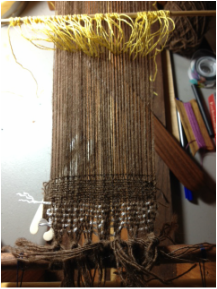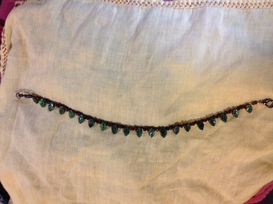Because this platform does not allow for effective use of bullets, I have opted to upload it as a document instead of a typical post.
|
This is the follow-up to my "Variations in Wool" article. These notes specifically refer to Viking era projects, but many items could pertain to anyone purchasing a whole fleece for use in a historical recreation project. This is not, however, meant to be a checklist of things you must do, or know, before planning a project. Rather, it is a compilation of things that I have learned (and learned to consider) during my own personal journey as an artisan. Because this platform does not allow for effective use of bullets, I have opted to upload it as a document instead of a typical post.
0 Comments
 I very much love geeking out with others who have a deep interest in textile arts and the internet is a fantastic way to connect with these individuals. One very interesting woman that I met via that medium is Lady Anne of Saffron Walden. We engaged in a discussion about growing, processing and bleaching linen on a Facebook group and later carried that discussion to private messages. I was very fortunate this year at Pennsic to have her come to my camp to show me her wonderful samples of handspun and handwoven linens as well as all of the swatches from her bleaching experiment. I recommend checking out her display if you ever have the chance (and talking to her in person is a delight). More information about her work raising flax and her fascinating experiments with whitening linen can be found here on her blog: http://mostlyaboutflax.blogspot.com/ One of the joys of my recent wool research is getting to experience first-hand so many amazing varieties of wool. Many of these come from sheep breeds purposely bred for different characteristics such has high fiber yield, staple length, crimp, etc. Through careful research we can determine which breed will supply the best type of fiber for a given project (historical or modern), but we often over look the fact that wool can vary with environmental factors, age, gender and even within the coat of a single sheep. (These notes specifically refer to Viking era or Norse projects, but many of the points could pertain to anyone working with fleece for a historical project.) When considering a whole fleece:
- Lambs born as twins produce less wool as adults than those that are singles. (Khan, 13763)
- Steely wool is cause by copper deficiency (loss of crimp, low tensile strength). Copper deficiency can also cause loss of pigment in dark colored sheep. (Khan, 13764) Zinc deficiency causes brittle wool, loss of crimp, and, when extreme, can cause the fleece to shed. Coming soon: Considerations When Choosing Wool for Your Historical Project My other sheep articles: http://awanderingelf.weebly.com/a-wandering-elfs-journey/category/sheep Resources: Dýrmundsson, Ólafur and Niznikowski, Roman. “North European short-tailed breeds of sheep : a review,” 59th Annual Meeting of the European Association for Animal Production. 2008 Ekarius, Carol and Robson, Deborah. The Fleece & Fiber Sourcebook: More Than 200 Fibers, from Animal to Spun Yarn (Storey Publishing, LLC), 2011. Khan, M. Jamshed. “Factors affecting wool quality and quantity in sheep”, African Journal of Biotechnology, Volume 11, 2012. Ostergaard, Else. Woven into the Earth: Textile finds in Norse Greenland (Aarhus University Press), 2004. Ryder, M. L. Sheep & Man (Gerald Duckworth & Co.), 1983. Ryder, M.L. “Survey of European primitive breeds of sheep”, Annales de génétique et de sélection animale, 1981. Last month a metal detectorist in Scotland discovered an exceptionally large find of Viking metal work. Several articles have surfaced since then (including a few with photos) and can be found at the links below:
http://www.churchofscotland.org.uk/news_and_events/news/2014/spectacular-viking-treasure-hoard-found-on-church-land http://www.theguardian.com/uk-news/2014/oct/13/-sp-metal-detector-enthusiastic-viking-treasure-hoard-scotland http://www.bbc.com/news/uk-scotland-south-scotland-29582866 I sit here on a Monday lamenting the lack of work I did on projects over the weekend. This was not, in fact, due to a lack of drive on my part, but rather it was a combination of my being sick and the necessity of taking care of a pressing mundane project.
Unfortunately, I often I find it hard to keep focus even when mundanity is not interfering. After all, there are so many things that are just begging to be made! I know this is an issue (my desire to do everything) and I have learned that I have to draw a line somewhere or I will have so many things going at once that I cannot, in reasonable time, ever finish anything. However, I I also understand that I need a certain amount of creative chaos or I lose interest in everything, as there is such a thing as "doing too much". To manage both my aspirations and time, I periodically have a heart-to-heart with my creative self. Knowing where my true passions lie helps me to weed out the things that seem exciting for a moment, but would not hold interest long enough to finish the work (a side tracking which in turn impedes the progress of the really inspiring items). For me, digging down deep into Viking costuming and fiber arts is really what keeps me motivated. Other things often spark my interest, but do not hold it for very long. I have learned to evaluate which new endeavours are likely to bear fruit and which are not, and if need be, I force myself to step away from an item or idea. Unlike many SCAdians who quilt or crochet or who make modern jewelery, mundane arts rarely grasp my heart long enough to see them completed, so I have learned to very seriously look at any anachronism that might grab my attention. Weaving a few quick scarves for holiday gifts? That is in the realm of possibility as I love giving hand made gifts. Therefore, undertaking a task like that could be part of a pleasant foray into mundane arts. Taking the time to make new machine embroidered new curtains for a guest bedroom? That is unlikely to ever happen, even though the idea has appealed to me at various points in time. After careful evaluation, I would need to step away from that project. Learning to weed out the less inspiring items, however, is only half of the solution to my organizational dilemma. To help maintain focus I sit down and map out my research into different areas. I list what I want the final goal to be for each (sometimes it is a final project resulting in an item and sometimes it is just a better understanding of a period practice). I then start working on materials for classes I plan to teach relating to these things (because to me, art and knowledge are both meant to be shared). Preparing class materials and notes forces me to deeply reevaluate my work and be more systematic about how I organize things. It shows me where my knowledge might be lacking in an area and it gives me time to conduct the additional research necessary to fill in those gaps. I make lists of items I need to create or source to help illustrate what I plan to teach and make plans to finish those items in time for a class (or a large A&S display). These are the projects I will work on for the foreseeable future. (Often, I also categorize those into "immediate" and "long-term".) And yes, I have multiple things going at once. Working on a single item at a time leads to me becoming almost immediately bored. To resolve that problem, but still maintain focus, I do keep the plethora of projects relevant to each other, which still provides some continuity in my work. For example, I currently am trying to update my sheep breeds research. This involves academic research but also spinning the newer samples I have acquired. In addition to that, I am working on a woven sampler of period Viking weave structures. I also am really intrigued about ways to produce the fine worsted yarn in some of the upper class "Birka type" fabrics so am doing additional spinning samples (and research) as time allows. The range of items helps me to keep my focus, and interest, without being so far across the board that it causes some sort of breakdown or road block that might render me incapable of proceeding with any of the projects. Having everything tied together also leads to unexpected revelations about one item while researching another, always a pleasant bonus. What happens when I get sidetracked too far? Last fall I choose to update my Ottoman research as I was asked to teach some classes and get information out about Ottoman costuming for Atlantian 12th Night. The research itself, and the resulting articles, was inspiring and something I greatly enjoyed, but the creation of the new costume that I felt I had to do for 12th Night was nothing but frustration because my heart was not in it. I have been more careful since then in evaluating how badly I want to create something before I start. In short, the way I best keep focus is:
I feel quite behind in my posts right now. Between the overload at my mundane work, the prep and research that went into my display for the event and the fact that I now seemed to have contracted some form of plague has me way behind on, well, everything. Despite all of this, I am quite happy to report that the Siege of Glengary was more amazing than it usually is! I had a wonderful time at Sylvan Glen's first Fiber Solar. We had more people show up that I had hoped for, and had several people try out spinning with a drop spindle and to test out a kick-wheel that Lady Bera had brought to show off. Two very young ladies tested out my rigid heddle loom as well and seemed to enjoy playing with that. Lady Rosamund was a lovely hostess and laid out a very nice table of munchies for everyone who came to play. A gentleman stopped by to show some photos he took in Ireland this summer at museums and digs that included images of some extant shoes, textiles and spinning tools. He carves bone and antler and I had quite an engaging discussion with him about the functionality of various types of spindle whorls. Actually, I had a good many great A&Sy type conversations throughout the day. More than once I was called over to the A&S Display area to explain the workings of a warp-weighted loom or the process of linen mangling to interested individuals. I am exceptionally honored to have won both competitions for the day as well, both the Royal Choice and the populace vote. My display consisted of the small warp-weighted loom I built warped with 12/1 linen (with a hand dyed tablet-woven starter band) and 8/1 linen as the weft. I had my hand spun linen singles on the spindles I used to craft it and the plied linen thread wound on a weaving quill. There was also a small Dublin cap handsewn with the same thread (and using a bronze needle crafted by Lord Takeda). I also displayed the linen mangling samples I did for Pennsic 42. After the Solar and Display ended it was time for Court. It was wonderful to see so many friends get well deserved rewards and I am most happy to report that despite the best efforts of Highland Foorde and their Atlantian allies, the Silver Apple shall remain in Sylvan Glen for another year. Feast was lovely (can I say I truly loved the cheese tart, the mushrooms, the honey cakes with fruit and honeyed whipped cream) and I shared it with a table of great friends. Following the feast there was dancing (something often missing from events these days). I am sad that I could not stay for the bardic, but mundane life had dictated that Glengary was not to be a camping event for me this year. In all, the event was incredible, and I cannot wait to attend again next year for the 20th Anniversary! As for what else is on the horizon... more research! I am trying to finish up some of my sheep breed research in preparation for teaching at FFF this year. I have additional samples to spin for that display as well. I also have found a few more articles about spinning period weight yarns for weaving that I want to dig deeper into, so I need to squeeze that line of research in as well. And finally, I cleaned off the Pennsic stash from my floorloom and I am ready to rewarp for a rug for my own tent for Pennsic. Perhaps I will be able to attend an SCA demo later this month and I am going to try (weather depending) to make it to Kingdom 12th Night this year as well. So much to look forward too! I shall now end this post with a gratuitous cat picture of my girls. |
About Me
I am mother to a billion cats and am on journey to recreate the past via costume, textiles, culture and food. A Wandering Elf participates in the Amazon Associates program and a small commission is earned on qualifying purchases.
Archives
July 2024
Categories
All
Blogroll of SCA & Costume Bloggers
Below is a collection of some of my favorite places online to look for SCA and historic costuming information.
More Amie Sparrow - 16th Century German Costuming Gianetta Veronese - SCA and Costuming Blog Grazia Morgano - 16th Century A&S Mistress Sahra -Dress From Medieval Turku Hibernaatiopesäke Loose Threads: Cathy's Costume Blog Mistress Mathilde Bourrette - By My Measure: 14th and 15th Century Costuming More than Cod: Exploring Medieval Norway |






 RSS Feed
RSS Feed